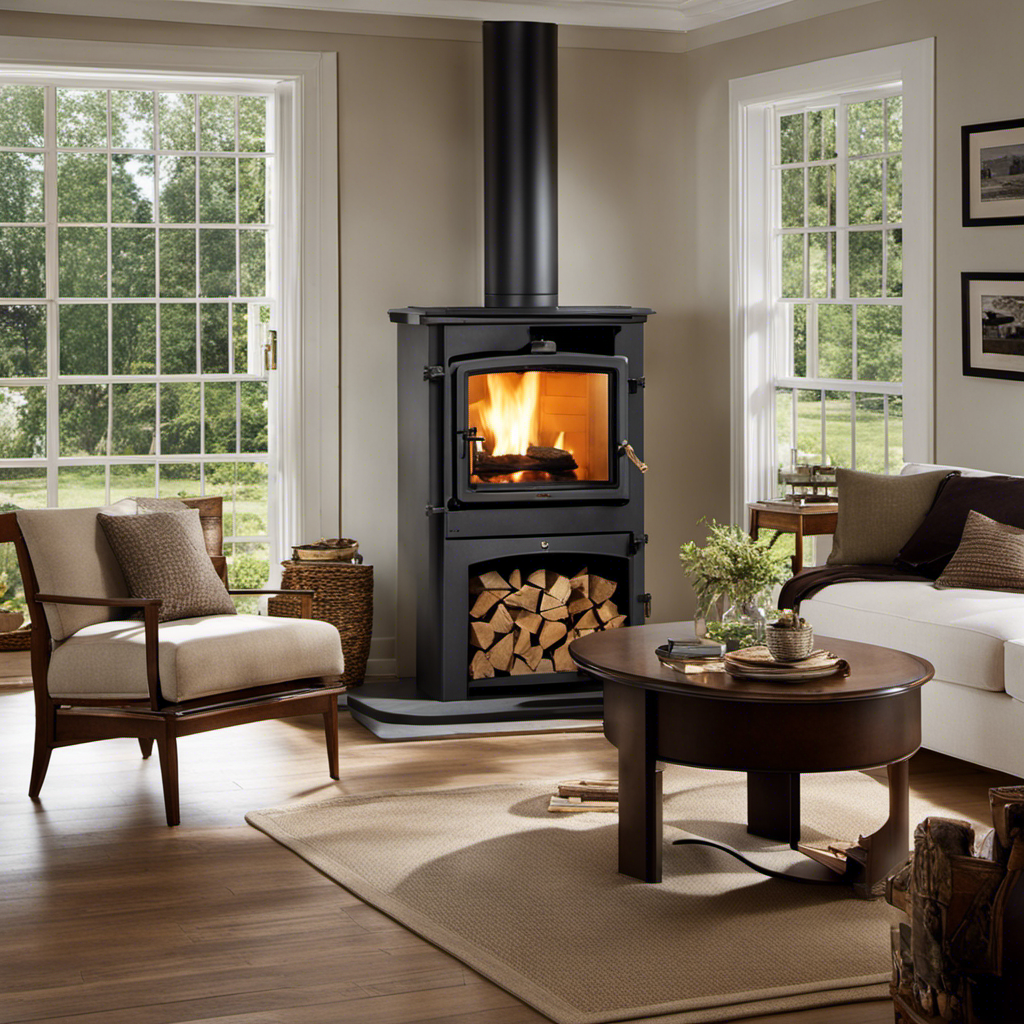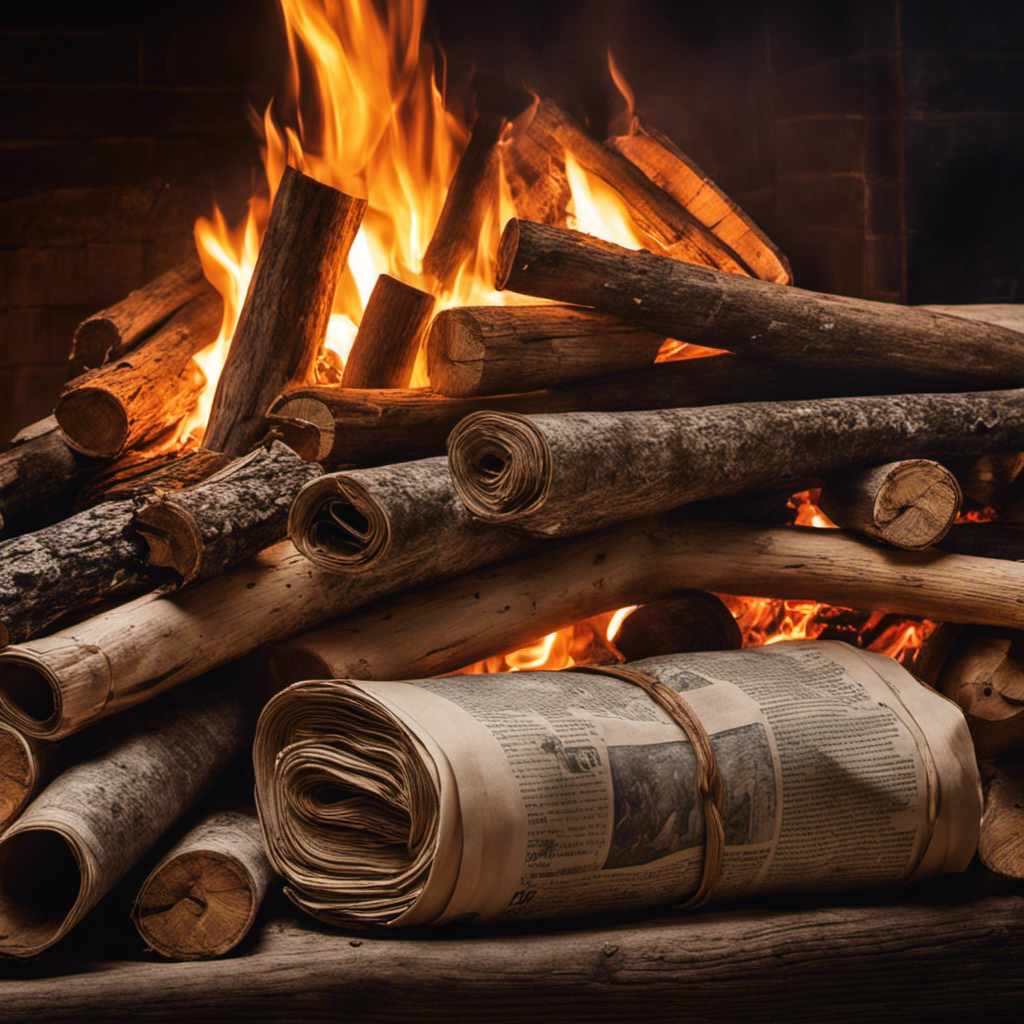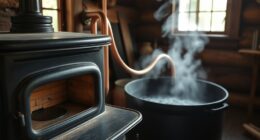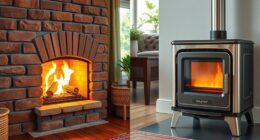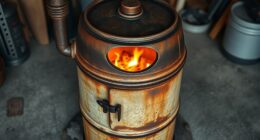We recognize the importance of protecting our homes, especially when it comes to high-efficiency wood-burning stoves.
In this article, we will explore the best practices for implementing safety measures that ensure the efficient and secure operation of these stoves.
From proper stove placement to maintaining and cleaning, we will cover all the necessary steps to keep our homes and loved ones protected.
So let’s dive in and learn how to effectively implement safety measures for high-efficiency wood burning stoves.
Key Takeaways
- Regular cleaning and inspection of wood burning stoves is crucial for safe operation.
- Fire safety training is important to understand potential hazards and prevent accidents.
- Proper ventilation is necessary to prevent gas accumulation and ensure safe operation.
- Maintaining proper stove placement and following safety measures are essential to minimize fire risks.
Fire Safety Measures for High-Efficiency Wood Burning Stoves
We should regularly clean and inspect our high-efficiency wood burning stoves to ensure fire safety. Proper maintenance is crucial for the safe operation of these stoves.
First and foremost, it’s essential to receive fire safety training to understand the potential hazards and preventive measures. This training equips us with the necessary knowledge to handle emergencies effectively.
Additionally, ensuring proper ventilation is vital to prevent the accumulation of harmful gases such as carbon monoxide. Regularly checking the ventilation system, including the chimney and flue, is essential to maintain proper airflow and prevent the risk of fire or gas leaks.
Importance of Carbon Monoxide Detectors in Wood Burning Stove Safety
We can’t stress enough the importance of carbon monoxide detectors in wood burning stove safety.
These devices are lifesavers, alerting us to the presence of this deadly gas that’s odorless and invisible.
Monitoring stove emissions is crucial to ensure the well-being of everyone in the household.
CO Detectors Save Lives
Installing CO detectors is crucial for the safety of our home when using high-efficiency wood burning stoves. These detectors save lives by alerting us to the presence of deadly carbon monoxide gas. When it comes to fire safety inspections, proper ventilation plays a vital role in preventing the build-up of harmful gases.
Here are three key reasons why CO detectors are essential:
-
Protection: CO detectors act as a shield, constantly monitoring the air quality and sounding an alarm if dangerous levels of carbon monoxide are detected.
-
Peace of Mind: Knowing that our home is equipped with CO detectors provides a sense of security, allowing us to enjoy the warmth and ambiance of our wood burning stove without worry.
-
Early Detection: Having CO detectors in place enables early detection of potential issues, allowing us to take immediate action and prevent a life-threatening situation.
Monitoring stove emissions is crucial to ensure the efficiency and safety of our wood burning stoves. Transitioning into the next section, let’s explore the importance of this aspect in detail.
Monitoring Stove Emissions Crucial
In order to ensure the efficiency and safety of our wood burning stoves, it’s crucial that we actively monitor stove emissions and utilize carbon monoxide detectors.
Stove emission monitoring allows us to identify any potential issues with the combustion process, ensuring that our stoves are operating at their peak performance. By regularly checking the emissions, we can detect and address any problems before they become major safety concerns.
In addition to monitoring, implementing safety measures such as carbon monoxide detectors is essential. These detectors provide an early warning system for the presence of this deadly gas, allowing us to take immediate action and prevent any harm.
By actively monitoring stove emissions and utilizing carbon monoxide detectors, we can ensure the efficiency and safety of our wood burning stoves.
Now, let’s move on to discussing safe operation tips for high-efficiency wood burning stoves.
Safe Operation Tips for High-Efficiency Wood Burning Stoves
Let’s remember to regularly clean the stovepipe to prevent potential chimney fires when using high-efficiency wood burning stoves. Proper stove maintenance is crucial for safe operation and optimal performance. Here are some important tips to keep in mind:
-
Firewood Storage: Store your firewood in a dry and well-ventilated area, away from the stove. This helps prevent the accumulation of moisture and reduces the risk of mold growth.
-
Stove Maintenance: Regularly inspect and clean your stove, paying special attention to the flue and chimney. Remove any creosote buildup to minimize the risk of chimney fires. Also, check the gaskets, seals, and other components for wear and tear, ensuring everything is functioning properly.
-
Airflow Regulation: Properly adjust the airflow to maintain a controlled burn and maximize efficiency. This helps prevent the stove from overheating and reduces the chances of accidental fires.
By following these safety measures, you can enjoy the warmth and comfort of your wood burning stove while ensuring the well-being of your home.
Now, let’s discuss the importance of proper stove placement to ensure safety and efficiency.
Proper Stove Placement to Ensure Safety and Efficiency
We need to consider the clearance requirements and ventilation options for the high-efficiency wood burning stove in order to achieve proper stove placement for safety and efficiency.
When it comes to installing a wood burning stove, it’s crucial to prioritize safety and efficiency. Proper stove placement involves ensuring adequate space between the stove and any combustible materials, as well as proper ventilation to prevent the buildup of harmful gases.
Additionally, regular maintenance is essential to keep the stove functioning optimally. This includes cleaning the chimney, inspecting the stove for any damage or wear, and ensuring proper airflow.
While some may choose to install the stove themselves, there are significant benefits to professional stove installation. Professionals have the expertise to ensure proper installation, reducing the risk of safety hazards and ensuring the stove operates efficiently.
Ensuring Child Safety Around Wood Burning Stoves
We should be mindful of the potential hazards and take proactive steps to ensure child safety around wood burning stoves. As responsible adults, it’s our duty to protect our children from harm. Here are some key measures we can take to childproof the stove area and educate our children about stove safety:
- Install a safety gate or barrier around the stove to keep children at a safe distance.
- Keep flammable materials, such as curtains or toys, away from the stove to prevent accidents.
- Teach children about the dangers of touching a hot stove and the importance of always asking an adult for help.
Maintaining and Cleaning High-Efficiency Wood Burning Stoves
As we discuss maintaining and cleaning high-efficiency wood burning stoves, it is important to regularly remove ash buildup to ensure optimal performance. Proper maintenance and cleaning techniques are essential for maintaining efficiency and promoting safety. To help you understand the importance of this topic, let’s take a closer look at some key maintenance tasks and cleaning techniques in the table below:
| Task | Frequency | Description |
|---|---|---|
| Ash removal | Weekly | Remove accumulated ash to prevent airflow obstruction |
| Glass cleaning | Monthly | Clean the glass to maintain a clear view of the fire |
| Chimney inspection | Annually | Check for any blockages or damage in the chimney |
| Gasket replacement | Every 2-3 years | Replace worn-out gaskets to ensure proper sealing |
| Professional servicing | Every 3-5 years | Seek professional help for a thorough inspection and tune-up |
Common Mistakes to Avoid When Using Wood Burning Stoves
Let’s discuss the common mistakes to avoid and improve our usage of wood burning stoves. When it comes to wood burning stove safety, it’s crucial to be aware of the common mistakes that can lead to dangerous situations. Here are some key points to keep in mind:
- Neglecting proper ventilation: Ensure that your wood burning stove is installed in a well-ventilated area to prevent the buildup of harmful gases.
- Burning unseasoned wood: Using wet or unseasoned wood can lead to excessive smoke and creosote buildup, increasing the risk of chimney fires.
- Overloading the stove: It’s important not to overload your stove with too much wood, as this can cause overheating and potentially damage the stove.
In addition to avoiding these common mistakes, it’s essential to prioritize the installation of carbon monoxide detectors in your home. These detectors can save lives by alerting you to the presence of this odorless and deadly gas. By taking these precautions, we can ensure the safe and efficient use of our wood burning stoves.
Now, let’s transition into discussing the best practices for storing firewood safely.
Best Practices for Storing Firewood Safely
When it comes to storing firewood safely, there are a few best practices to keep in mind.
First, it’s important to choose a location that’s away from your home and any other structures, as this can prevent the spread of fire in case of accidents.
Second, make sure to stack the firewood off the ground and in a well-ventilated area, as this can help prevent moisture buildup and discourage pests from making a home in your woodpile.
Firewood Storage Tips
We need to stack the firewood properly to ensure it doesn’t get damp or rot. Proper firewood storage is crucial for maintaining its quality and efficiency. Here are some tips to help you store your firewood effectively:
-
Elevate the wood: Place the firewood on a raised platform or pallets to keep it off the ground. This prevents moisture from seeping into the wood.
-
Allow for airflow: Ensure that there’s enough space between the stacked logs to allow air circulation. This helps in drying the wood and reducing its moisture content.
-
Cover it up: Use a waterproof cover to protect the firewood from rain or snow. It’s important to keep the top covered while leaving the sides open for ventilation.
Preventing Firewood Pest
Our best defense against firewood pests is to regularly inspect our stored firewood and promptly remove any signs of infestation.
Preventing infestation starts with proper firewood storage methods. It’s essential to keep the firewood elevated off the ground, as pests are less likely to infest wood that isn’t in direct contact with the soil. Additionally, storing firewood away from buildings and structures reduces the risk of pests spreading indoors.
To further prevent infestation, it’s crucial to stack firewood loosely, allowing for proper airflow and drying. This helps discourage pests from making the wood their home.
Regularly checking the firewood for signs of insects or damage, such as boreholes or wood dust, can help identify and address any infestation early on.
What Safety Measures Should Be Followed When Upkeeping High-Efficiency Wood Burning Stoves?
When it comes to efficient wood burning stoves upkeep, safety should be the top priority. Regularly inspect the stove for any damage or wear and tear. Always follow the manufacturer’s instructions for proper maintenance and ventilation. Keep flammable materials at a safe distance and use a fire screen for added protection.
Additional Safety Precautions for High-Efficiency Wood Burning Stoves
Let’s install carbon monoxide detectors near our high-efficiency wood burning stoves for added safety. Ensuring the well-being of our homes and loved ones should always be a top priority.
Here are some key measures to implement when using these stoves:
-
Regularly clean and maintain the chimney to prevent blockages and reduce the risk of fire. Remember, safety starts from the top.
-
Keep a safe distance between the stove and any flammable materials, such as curtains or furniture, to minimize the chance of accidental ignition.
-
Use a fire-resistant hearth or floor protector, creating a designated space that shields against potential sparks or embers.
Frequently Asked Questions
Are High-Efficiency Wood Burning Stoves More Expensive Than Traditional Stoves?
High-efficiency wood burning stoves can be more expensive than traditional stoves, but the cost comparison depends on factors like installation and fuel prices. However, they have a lower environmental impact, making them a worthwhile investment for those seeking liberation.
Can High-Efficiency Wood Burning Stoves Be Used in Any Type of Home?
High-efficiency wood burning stoves can be used in any type of home, including urban areas and older homes. They are a safe and effective option for heating, but it’s important to implement proper safety measures.
What Are the Benefits of Using High-Efficiency Wood Burning Stoves?
Using high-efficiency wood burning stoves offers numerous benefits, such as increased heat output and reduced fuel consumption. The efficiency of these stoves allows us to enjoy the warmth of a fire while being environmentally conscious and saving money on heating costs.
Are There Any Government Regulations or Certifications for High-Efficiency Wood Burning Stoves?
Government regulations and certification requirements for high-efficiency wood burning stoves vary by country and region. It is important to research and comply with these guidelines to ensure the safe and effective use of these stoves.
Are There Any Special Maintenance Requirements for High-Efficiency Wood Burning Stoves?
To effectively implement safety measures for high-efficiency wood burning stoves, special maintenance is required. Regular cleaning is essential to prevent creosote buildup, which can lead to chimney fires.
Conclusion
In conclusion, implementing safety measures for high-efficiency wood burning stoves is crucial to ensure the well-being of your home and loved ones.
While it may seem ironic that these efficient stoves, designed to provide warmth and comfort, require careful attention and precautions, it’s essential to prioritize safety.
By following the tips outlined in this article and being mindful of potential hazards, you can enjoy the benefits of a wood burning stove without compromising on safety.
Stay warm, stay safe.
Logan’s affair with adventure began in childhood. He hailed from a small town where vast forests bordered one side and endless shores stretched on the other. His days were spent exploring uncharted woods, climbing tall trees, or listening to the tales of old sailors. This early immersion in a world brimming with stories and mysteries became the foundation of his passion for writing.

